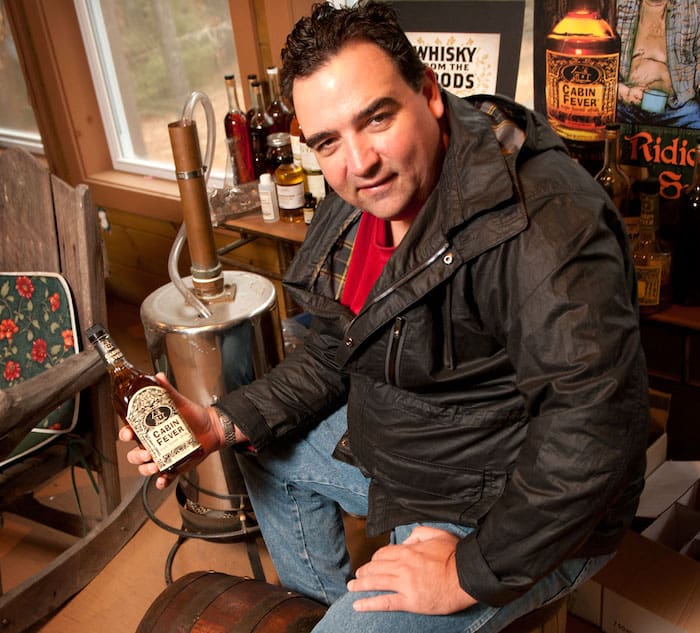by Tony Sachs
While we American whiskey drinkers are enjoying a golden age for craft distilleries, craft distillers are enjoying a golden age of acquisition. High West, Smooth Ambler, and Westland are just a few of the small independent distilleries to have been bought by industry behemoths like Diageo and Pernod Ricard in the last couple of years. Acquisitions inject needed capital into their operations, and make their owners very wealthy individuals. If there’s a downside, it would take a microscope to spot it. But one craft distiller has gone in the opposite direction, from corporate cog back to an indie brand. And he’s thrilled about it.
Rob Robillard was an optical engineer and self-proclaimed “maple ambassador” who traveled around the world on business, always bringing with him maple syrup from his native New Hampshire. He was also experimenting with making whiskey. “I was trying to come up with something — I knew that a maple whiskey would work. So I was doing my own still and playing around with maple.” Eventually he hit on a formula: “I didn’t want it to be too sweet, so when I infuse the maple into the whiskey, I actually chill-filter it, so the maple flavors go through the filter, but not all the sugar. That was the concept.” The result was Cabin Fever Maple Whiskey, which launched in 2001 — it was one of the first flavored whiskeys on the market. In fact, Robillard claims he inspired Wild Turkey to stop calling its American Honey brand a liqueur: “I saw them out by their facility, and they said, ‘You’re the reason why we changed it from a liqueur to a flavored whiskey.’”

In 2006, Robillard quit his job to devote himself to Cabin Fever full-time. Sales were strong in New England, but as is the case with most small businesses, cashflow was an issue. Which is why, when Diageo came knocking in 2012, he was more than receptive to being bought out. “I needed a little money up front,” he says. “I mean, I was saving up to get my muffler fixed. I needed the money. And then I needed to always be part of the brand. So I was always gonna get royalties, and I was always going to be the face of the brand and always be part of it, and that was important to me. Some people want to create the brand and they want to sell it, but they want nothing to do with it, they don’t want to travel. Me, I always wanted to be part of the brand.”
In theory, it was the perfect deal. And Robillard, still the public face of Cabin Fever even if he was no longer distilling the product himself, agreed, at least at first. “We traveled like rock stars,” he says. “We had private jets — we would fly in the morning, and then we’d take you out to dinner, and then we’d go to the clubs, and then we’d go to the hotel, and the next morning we’d fly to the next city, and do the whole thing all over.” But Cabin Fever never wound up meeting expectations, sales-wise. Robillard attributes the problem to Diageo’s attempt to turn it from a regional brand to a national one. “You can’t sell maple down south, they don’t even know what it is…. So it was kind of dying on the vine.”
Something less quantifiable had changed as well. “I put it in the contract that the recipe can’t be changed. I would buy a case of my Cabin Fever and a case of Diageo’s, and I couldn’t tell the difference. But it just didn’t feel the same. I mean, you can call it craft, and you can make it the same way, but you can almost say the definition of craft is anything not Diageo.”
In 2016, four years after acquiring Cabin Fever, Diageo offered Robillard his brand back — for free. “They actually gave it back,” he says, “and I still have a great relationship with them.” It took about a year for Robillard to get his operation back up and running; he kept the brand on the market by buying it from suppliers in markets where it hadn’t done well: “Alabama couldn’t sell it, well, hey, I’ll take your stock. So that got me by.”
Robillard is thrilled to be running the show at Cabin Fever again. “I’ve got to tell you, I feel like I’m in love again!” he says. “When you’re doing something for yourself — you might be digging a trench, but if it’s your trench, you don’t mind digging it, you know?” To distillers who are weighing buyout offers today, he has some advice: “What you have to do is find out what you want to do with yourself after the deal. You have to customize the deal to satisfy your own desires and needs…. I flew in those private jets. But I mean, it felt good for about three months, but it doesn’t feel nearly as good as it does now to have my brand back.”
Besides keeping the Cabin Fever flame burning in New England, Robillard has developed an experimental whiskey called Walrus Blood, for which he hopes to find a distributor as soon as possible. “I don’t think I’ll ever stop doing this,” he says. “It’s just, like, in my blood now. I always have to be creating stuff and doing stuff and going on.”







